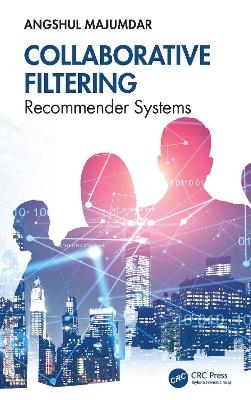
Collaborative Filtering
CRC Press (Verlag)
978-1-032-84082-6 (ISBN)
Collaborative filtering reigns supreme as the dominant approach behind recommender systems. This book offers a comprehensive exploration of this topic, starting with memory-based techniques. These methods, known for their ease of understanding and implementation, provide a solid foundation for understanding collaborative filtering. As you progress, you’ll delve into latent factor models, the abstract and mathematical engines driving modern recommender systems.
The journey continues with exploring the concepts of metadata and diversity. You’ll discover how metadata, the additional information gathered by the system, can be harnessed to refine recommendations. Additionally, the book delves into techniques for promoting diversity, ensuring a well-balanced selection of recommendations. Finally, the book concludes with a discussion of cutting-edge deep learning models used in recommender systems.
This book caters to a dual audience. First, it serves as a primer for practicing IT professionals or data scientists eager to explore the realm of recommender systems. The book assumes a basic understanding of linear algebra and optimization but requires no prior knowledge of machine learning or programming. This makes it an accessible read for those seeking to enter this exciting field. Second, the book can be used as a textbook for a graduate-level course. To facilitate this, the final chapter provides instructors with a potential course plan.
Key features:
· This is the only book covering 25 years of research on this topic starting from late 90s to the current year.
· This book is accessible to anyone with a basic knowledge of linear algebra, unlike other volumes that require knowledge of advanced data analytics.
· It covers a wider range of topics than other books. Most others are research oriented and delves deep into a narrow area.
· This is the only book written to be a textbook on collaborative filtering and recommender systems.
· The book emphasizes on algorithms and not implementation. This makes it agnostic to programming languages. The reader is free to use whatever they are comfortable in, such as Python, R, Matlab, Java, etc.
Angshul Majumdar is currently a professor at TCG CREST, Kolkata. Prior to that he was a professor at Indraprastha Institute of Information Technology, Delhi, India. He has been associated with the institute since 2012. Angshul did his Master’s (2009) and PhD (2012) in electrical and computer engineering from the University of British Columbia, Vancouver, Canada. Angshul’s research interests lie in signal processing and machine learning with applications in smart grids and bioinformatics. Angshul has co-authored over 200 articles in journals and top tier conferences. He has written two books and co-edited two more and holds 7 US patents. He is an associate editor for IEEE Open Journal for Signal Processing and Elsevier Neurocomputing. In the past, he has been an associate editor for IEEE Transactions on Circuits and Systems for Video Technology. Angshul is currently the director of student services at IEEE Signal Processing Society. Prior to that he was the chair for the education committee in the IEEE SPS membership board (2019). Angshul has also served as the chair for the chapter’s committee in the IEEE SPS membership board (2016-18). He had been the founding chair of IEEE SPS Delhi Chapter (2015-18). Angshul has been the organizing chair of two IEEE SPS Winter Schools in 2014 and 2017. He has served as the finance chair of IEEE ISBA 2017, the flagship conference of IEEE Biometrics Council.
Chapter 1 Introduction and Organization 1.1 Introduction 1.2 Contents of This Book Chapter 2 Neighborhood-Based Models 2.1 Introduction 2.2 User-Based Approach 2.3 Item-Based Approach Chapter 3 Ratings 3.1 Introduction 3.2 Biases and Baseline Correction 3.3 Significance Weighting 3.4 Optimally Learned Interpolation Weights Chapter 4 Latent Factor Models 4.1 Introduction 4.2 Latent Factor Model 4.3 Nuclear Norm Minimization Chapter 5 Using Metadata 5.1 Introduction 6.2 Prior Art 6.3 Matrix Factorization-Based Diversity Model 6.4 Nuclear Dorm-Based Diversity Model Chapter 7 Deep Latent Factor Models 7.1 Introduction 7.2 Brief Introduction to Representation Learning 7.3 Deep Latent Factor Model 7.4 Graphical Deep Latent Factor Model 7.5 Diversity in Deep Latent Factor Model Chapter 8 Conclusion and Note to Instructors 8.1 Introduction 8.2 Course Organization 8.3. Expectation from Pupils 8.4 Evaluation
| Erscheinungsdatum | 22.08.2024 |
|---|---|
| Zusatzinfo | 10 Line drawings, black and white; 10 Illustrations, black and white |
| Verlagsort | London |
| Sprache | englisch |
| Maße | 156 x 234 mm |
| Gewicht | 421 g |
| Themenwelt | Mathematik / Informatik ► Informatik ► Theorie / Studium |
| Technik ► Elektrotechnik / Energietechnik | |
| Technik ► Umwelttechnik / Biotechnologie | |
| ISBN-10 | 1-032-84082-X / 103284082X |
| ISBN-13 | 978-1-032-84082-6 / 9781032840826 |
| Zustand | Neuware |
| Haben Sie eine Frage zum Produkt? |
aus dem Bereich


